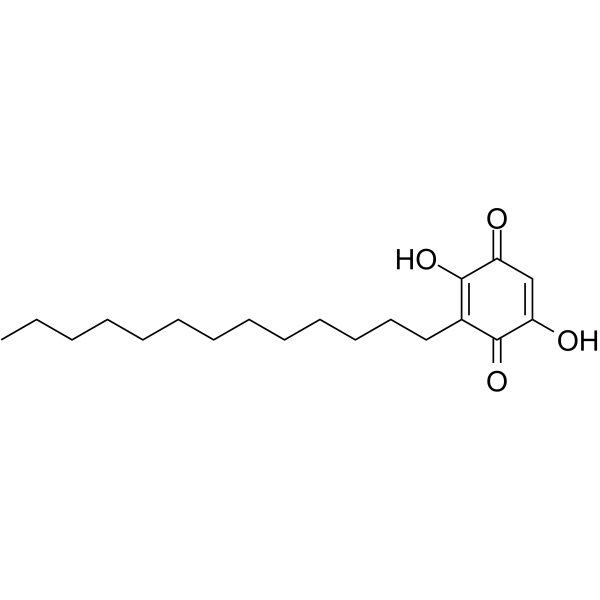Physicochemical Properties
| Molecular Formula | C19H30O4 |
| Molecular Weight | 322.44 |
| Exact Mass | 322.214 |
| CAS # | 573-40-0 |
| PubChem CID | 100659 |
| Appearance | Light yellow to orange solid powder |
| Density | 1.099g/cm3 |
| Boiling Point | 457ºC at 760mmHg |
| Melting Point | 142-145ºC |
| Flash Point | 244.3ºC |
| Index of Refraction | 1.53 |
| LogP | 5.093 |
| Hydrogen Bond Donor Count | 2 |
| Hydrogen Bond Acceptor Count | 4 |
| Rotatable Bond Count | 12 |
| Heavy Atom Count | 23 |
| Complexity | 460 |
| Defined Atom Stereocenter Count | 0 |
| InChi Key | AMKNOBHCKRZHIO-UHFFFAOYSA-N |
| InChi Code | InChI=1S/C19H30O4/c1-2-3-4-5-6-7-8-9-10-11-12-13-15-18(22)16(20)14-17(21)19(15)23/h14,20,23H,2-13H2,1H3 |
| Chemical Name | 2,5-dihydroxy-3-tridecylcyclohexa-2,5-diene-1,4-dione |
| HS Tariff Code | 2934.99.9001 |
| Storage |
Powder-20°C 3 years 4°C 2 years In solvent -80°C 6 months -20°C 1 month |
| Shipping Condition | Room temperature (This product is stable at ambient temperature for a few days during ordinary shipping and time spent in Customs) |
Biological Activity
| Targets | PLA2 2.6 μM (IC50) |
| ln Vitro | In primary rats hepatocytes and HepG2 cells, rapanone (10–40 μM; 24 h) reduces cell viability with IC50s of 35.58 μM and 27.89 μM, respectively[1]. HepG2 cells are exposed to rapanone (10–40 μM) for 24 hours, which causes concentration-dependent ATP depletion, phosphatidyl serine externalization, hydrogen peroxide formation, and mitochondrial membrane potential dissipation[1]. Rapanone induces mitochondrial dysfunction by blocking electron transport at Complex III[1]. |
| ln Vivo | Mice with the carrageenan paw oedema paradigm have anti-inflammatory benefits when exposed to rapanone (2.5-10 mg/kg; ip)[4]. |
| References |
[1]. Rapanone, a naturally occurring benzoquinone, inhibits mitochondrial respiration and induces HepG2 cell death. Toxicol In Vitro. 2020 Mar;63:104737. [2]. Antileishmanial compounds from Connarus suberosus: Metabolomics, isolation and mechanism of action. PLoS One. 2020 Nov 6;15(11):e0241855. [3]. Discerning the antioxidant mechanism of rapanone: A naturally occurring benzoquinone with iron complexing and radical scavenging activities. J Inorg Biochem. 2017 May;170:134-147. [4]. Inhibition of acute and chronic inflammatory responses by the hydroxybenzoquinonic derivative rapanone. Planta Med. 2001 Dec;67(9):791-5. |
| Additional Infomation |
Rapanone is a member of dihydroxy-1,4-benzoquinones. Rapanone has been reported in Tapeinosperma pseudojambosa, Embelia schimperi, and other organisms with data available. |
Solubility Data
| Solubility (In Vitro) | DMSO : 25 mg/mL (77.53 mM) |
| Solubility (In Vivo) |
Solubility in Formulation 1: ≥ 2.5 mg/mL (7.75 mM) (saturation unknown) in 10% DMSO + 90% Corn Oil (add these co-solvents sequentially from left to right, and one by one), clear solution. For example, if 1 mL of working solution is to be prepared, you can add 100 μL of 25.0 mg/mL clear DMSO stock solution to 900 μL of corn oil and mix evenly. (Please use freshly prepared in vivo formulations for optimal results.) |
| Preparing Stock Solutions | 1 mg | 5 mg | 10 mg | |
| 1 mM | 3.1014 mL | 15.5068 mL | 31.0135 mL | |
| 5 mM | 0.6203 mL | 3.1014 mL | 6.2027 mL | |
| 10 mM | 0.3101 mL | 1.5507 mL | 3.1014 mL |
